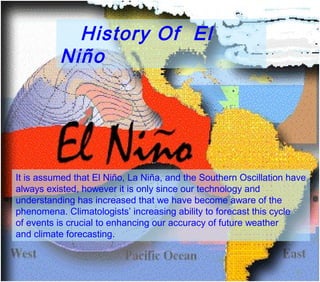
History of El Niño Weather Phenomenon
- 1. History Of El Niño It is assumed that El Niño, La Niña, and the Southern Oscillation have always existed, however it is only since our technology and understanding has increased that we have become aware of the phenomena. Climatologists’ increasing ability to forecast this cycle of events is crucial to enhancing our accuracy of future weather and climate forecasting.
- 2. Sequence • Pacific Ocean • Normal Conditions • El Niño Conditions • Areas with pronounced Effects • Effects of El Niño on world weather
- 3. N Asia Northern North America Pacific Ocean Equator Central Eastern Western Pacific Basin Pacific Ocean Pacific Ocean South Australia America Southern Pacific Ocean Antarctica S
- 4. Normal Conditions •Cool water upwelling off the west coast of S. America makes the thermocline shallow and pressure high •Strong trade winds push warm waters westwards - piling up near New Guinea and Australia (thermocline Deepens). •Sea level increases (40cm) and increase In temp (6 -70C) •Strong east-west surface pressure gradient across the tropical Pacific. •Walker circulation. •Heavy rains are concentrated in the western Pacific Ocean.
- 5. Typical Walker circulation pattern Air circulation in a vertical plane at the equator L Darwin Strong Easterly Trades South Australia Tahiti America Typical summer Warmer Sea Colder Sea H Positions of high Surface winds Pressure systems
- 6. Typical Walker circulation pattern Air circulation in a vertical plane at the equator L Darwin Strong Easterly Trades South Australia Tahiti America Typical summer Warmer Sea Colder Sea H Positions of high Surface winds Pressure systems